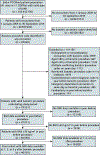Comparative Effectiveness and Safety of Bariatric Procedures for Weight Loss: A PCORnet Cohort Study
- PMID: 30383139
- PMCID: PMC6652193
- DOI: 10.7326/M17-2786
Comparative Effectiveness and Safety of Bariatric Procedures for Weight Loss: A PCORnet Cohort Study
Abstract
Background: There has been a dramatic shift in use of bariatric procedures, but little is known about their long-term comparative effectiveness.
Objective: To compare weight loss and safety among bariatric procedures.
Design: Retrospective observational cohort study, January 2005 to September 2015. (ClinicalTrials.gov: NCT02741674).
Setting: 41 health systems in the National Patient-Centered Clinical Research Network.
Participants: 65 093 patients aged 20 to 79 years with body mass index (BMI) of 35 kg/m2 or greater who had bariatric procedures.
Intervention: 32 208 Roux-en-Y gastric bypass (RYGB), 29 693 sleeve gastrectomy (SG), and 3192 adjustable gastric banding (AGB) procedures.
Measurements: Estimated percent total weight loss (TWL) at 1, 3, and 5 years; 30-day rates of major adverse events.
Results: Total numbers of eligible patients with weight measures at 1, 3, and 5 years were 44 978 (84%), 20 783 (68%), and 7159 (69%), respectively. Thirty-day rates of major adverse events were 5.0% for RYGB, 2.6% for SG, and 2.9% for AGB. One-year mean TWLs were 31.2% (95% CI, 31.1% to 31.3%) for RYGB, 25.2% (CI, 25.1% to 25.4%) for SG, and 13.7% (CI, 13.3% to 14.0%) for AGB. At 1 year, RYGB patients lost 5.9 (CI, 5.8 to 6.1) percentage points more weight than SG patients and 17.7 (CI, 17.3 to 18.1) percentage points more than AGB patients, and SG patients lost 12.0 (CI, 11.6 to 12.5) percentage points more than AGB patients. Five-year mean TWLs were 25.5% (CI, 25.1% to 25.9%) for RYGB, 18.8% (CI, 18.0% to 19.6%) for SG, and 11.7% (CI, 10.2% to 13.1%) for AGB. Patients with diabetes, those with BMI less than 50 kg/m2, those aged 65 years or older, African American patients, and Hispanic patients lost less weight than patients without those characteristics.
Limitation: Potential unobserved confounding due to nonrandomized design; electronic health record databases had missing outcome data.
Conclusion: Adults lost more weight with RYGB than with SG or AGB at 1, 3, and 5 years; however, RYGB had the highest 30-day rate of major adverse events. Small subgroup differences in weight loss outcomes were observed.
Primary funding source: Patient-Centered Outcomes Research Institute.
Figures



Comment in
-
PCORnet Bariatric Surgery Outcomes: Strength in Numbers.Ann Intern Med. 2018 Dec 4;169(11):806-807. doi: 10.7326/M18-2819. Epub 2018 Oct 30. Ann Intern Med. 2018. PMID: 30383123 No abstract available.
-
Is RYGB more effective than sleeve gastrectomy?Nat Rev Endocrinol. 2019 Mar;15(3):134-135. doi: 10.1038/s41574-018-0152-8. Nat Rev Endocrinol. 2019. PMID: 30607033 No abstract available.
References
-
- Ponce J, DeMaria EJ, Nguyen NT, Hutter M, Sudan R, Morton JM. American Society for Metabolic and Bariatric Surgery estimation of bariatric surgery procedures in 2015 and surgeon workforce in the United States. Surg Obes Relat Dis. 2016;12:1637–9. [PMID: 27692915] doi:10.1016/j.soard.2016.08.488 - DOI - PubMed
Publication types
MeSH terms
Associated data
Grants and funding
LinkOut - more resources
Full Text Sources
Medical
Research Materials
